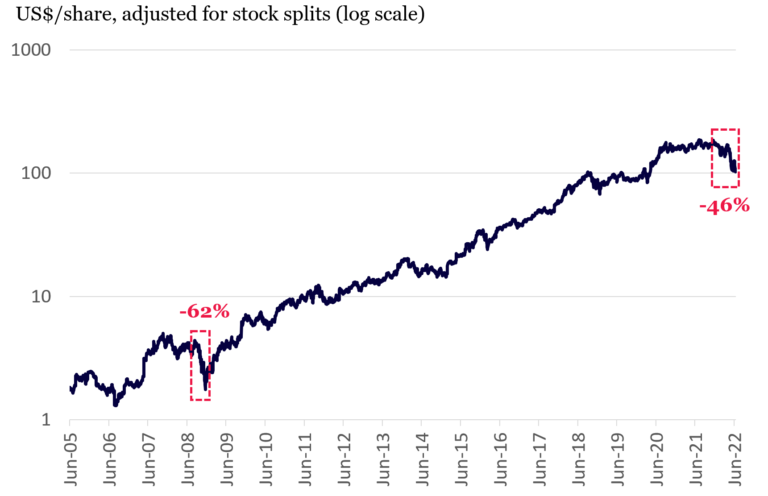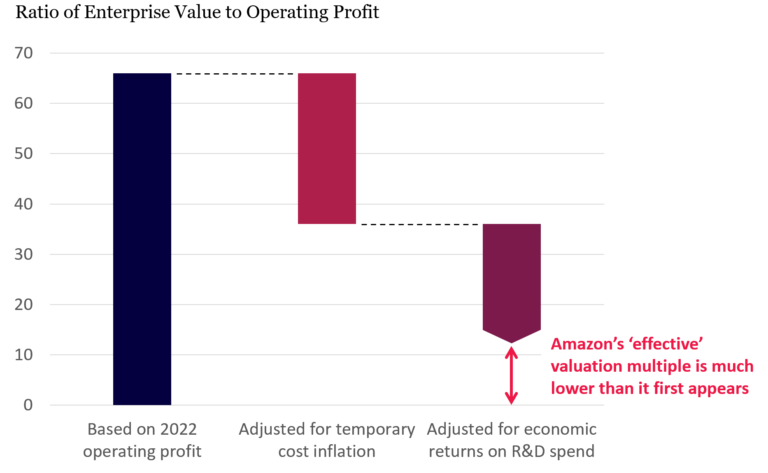Why Amazon should top your 'bear-market bargain' list
What do you call a company that, when it surprises the market with very strong free cash flow, sees its stock crash 30 percent?
Amazon!
In its first-quarter earnings report some months ago, the market focused on Amazon reporting higher-than-expected costs (and lower corresponding profits). Having dramatically accelerated the company’s fulfillment and transportation capacity to meet the booming demand of the pandemic, Amazon is now temporarily carrying too much capacity. This, combined with generally elevated rates of inflation, was the source of these higher expenses.
But the market ignored that these higher costs are largely temporary.
And it totally ignored that these higher costs were more than offset by Amazon’s significantly lower investment in its logistics network, which resulted in much better-than-expected free cash flow generation, a vital metric of any company’s health.
Historical Amazon stock price

After the recent post-earnings sell-off, Amazon’s stock has now slumped 46% from its all-time-high one year ago. That makes it the stock’s biggest drawdown since the GFC, just over 13 years ago.
The slump suggests the market believes Amazon’s future has turned into a tale of woe.
But these prices represent a rare and extraordinary buying opportunity in Amazon. Here are three key reasons why Amazon remains a brilliant story and why bargain hunters should be looking at the stock.
1. One of the highest-quality portfolios of businesses the world has ever known
To many investors, Amazon is primarily a retailer with high fixed (and now inflating) costs. With the world now on the cusp of a recession, it hardly seems like the appropriate time to get excited about this company.
Amazon, however, is one of history’s great conglomerates, like Standard Oil or Berkshire Hathaway. But the important difference is that the company is overwhelmingly built on software, which allows it to exploit the self-reinforcing power of data and AI to create new products and build huge competitive advantages.
Amazon has three pillars — Marketplace, Prime and AWS – where Amazon is the leading player in large, rapidly growing and economically attractive global markets. The opportunities for value creation within these three pillars over the next decade and beyond remain immense.
When it comes to Amazon’s e-commerce platform Marketplace, one needs to remember that 85% of retail shopping is still done offline. Amazon believes this ratio between online and offline retail will eventually flip and online will dominate. By continuing the company’s relentless focus on the customer experience, Amazon is well-positioned to win from this shift by providing two million third-party sellers with retail, advertising, fulfillment, distribution, and other tools, that help them grow their businesses online.
In Prime, more than 200 million Amazon customers subscribe to Prime to receive benefits such as better delivery terms, access to video, music, games and other exclusive offers. Amazon continues to invest heavily in these Prime benefits, increasing its value to subscribers. Amazon, for example, recently acquired film studio MGM. It now exclusively owns more than 21,000 TV and film content pieces, including the James Bond series. It also adds the NFL’s Thursday Night Football from this September.
J.P. Morgan (JPM) estimates the value of Prime to subscribers is more than US$1,100 per year. That’s nearly eight times the US subscription cost of US$139. JPM also estimates that, internationally, Amazon is only one-third penetrated into online households. This suggests the company can generate substantial long-term growth in revenues from higher prices, more subscribers, and the fact that the average Prime subscriber spends more than double that of a non-subscriber on the platform. (Importantly, the profit margin on new subscriptions revenues is very high.)
With AWS, Amazon is the global leader in cloud and distributed computing, a market that will see its revenue more than quadruple over the next decade as more big organisations increase digital capabilities, the Internet of Things (IoT) explodes, and the growth in new (compute-intensive) AI-based applications accelerates. With exceedingly high barriers to entry, the existing oligopoly of Microsoft, Alphabet and Amazon can expect to earn huge profit margins on these additional revenues.
2. Growth options that will unearth additional future ‘pillars’
Amazon also has massive growth potential from new products and businesses.
Amazon has evolved from a books-only retailer to the extraordinary, interconnected conglomerate it is today because it methodically evaluates and invests in high-potential growth options that satisfy four criteria:
- The prize, if successful, is extremely large
- The new market is currently not well-served
- Amazon could bring a differentiated approach to serving customers; and
- Amazon has the competence required to win (or could acquire it quickly).
In a Bloomberg interview last month, Amazon CEO, Andy Jassy, explained how the company continues to employ this framework in seeking to unlock its fourth pillar, and then its fifth.
Jassy sees several potential growth options that are already well-progressed. Each has the potential to grow into Amazon’s next ‘pillar’ over time.
Alexa, for example, is already a world-leading personal assistant, leveraging Amazon’s strengths in AI and giving customers access to Amazon’s many offerings via verbal conversation. Already, Alexa has more than 200 million connected devices in use today.
Amazon’s Project Kuiper is another possible pillar. It is a roadmap to launch a constellation of 3,236 satellites that orbit low to earth which provide affordable broadband to 300-400 million people around the world that currently have limited or no internet access. According to Jassy, this opportunity has “AWS characteristics”, which suggests a platform business model. It’s not hard to imagine Amazon clipping the ticket by allowing other businesses to provide their services to these users, while also profiting from providing Amazon services to the user base.
Or what about Zoox? Zoox is Amazon’s offering in the AI-intensive autonomous driving (AV) and ride-hailing space, another multi-hundred billion dollars per year market. Interestingly, while other prominent AV developers are working with automakers to match their AV systems with vehicles, Zoox is working directly with the auto parts makers that supply components to vehicle manufacturers.
As Jassy says, “if any one of them [Alexa, Project Kuiper or Zoox] becomes the fourth pillar for us … we’re a completely different company…”
3. Amazon appears expensive but is actually cheap
Amazon shares are now also cheap.
After the recent sell-off, investors could be forgiven for feeling puzzled when evaluating Amazon. When expected free cash flow increases, the stock falls! And despite stock almost halving – the most since the GFC – the ratio of the company’s enterprise value to 2022 operating income still appears very high at 66x. Surely if it takes 66 years to earn back one’s initial investment, then Amazon is very expensive – even today?
But while optically expensive, Amazon is actually very cheap because the operating profit the business will generate in 2022 will pale in comparison to the operating profit in future years, for two reasons. Firstly, the inflationary pressures and excess logistics capacity mentioned above have temporarily halved earnings. And secondly, while Amazon’s significant investments in R&D are being fully expensed today (depressing earnings), those investments will materially increase future earnings power.
Amazon’s (misperceived) valuation multiple

If we adjust for both these dynamics, we get an ‘effective’ earnings multiple of well below 15x today, certainly well below the optically-expensive 66x unadjusted valuation multiple. For a business of Amazon’s extreme quality, this looks like an extraordinary investment opportunity.
Opportunities to buy Amazon at bargain basement prices don’t come around very often. The last time was during the GFC. We believe today is one of those times.
Note: Montaka is invested in Amazon.
Compound your wealth over the long-term
Montaka Global Investments provides investors with the opportunity to compound wealth over the long term through disciplined global investment strategies and a sophisticated approach to risk management. Get in touch with us through the 'CONTACT' button below.
4 topics
1 stock mentioned

